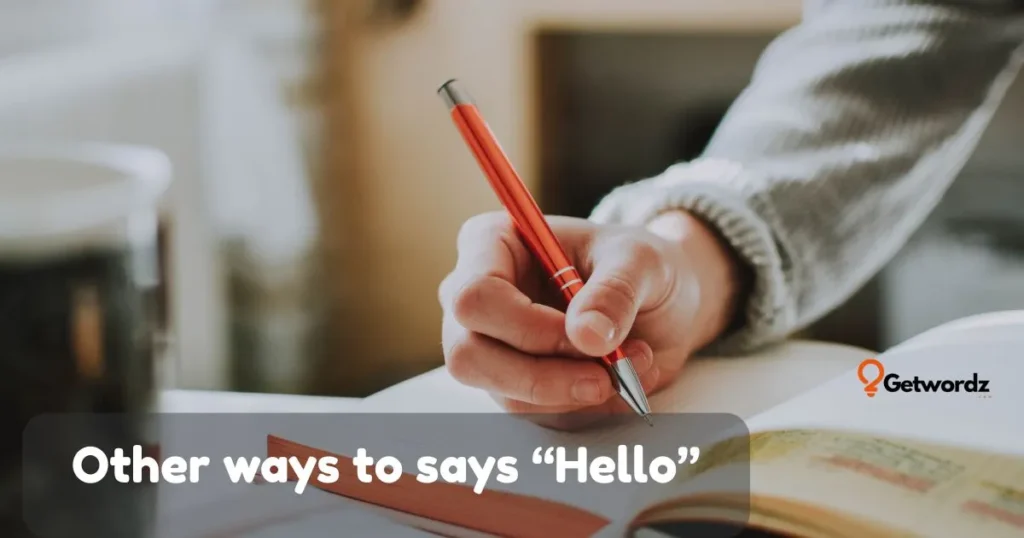Hello is more than just a simple greeting, it’s the doorway to connection, whether you’re reaching out to friends, colleagues, family, or that special someone. While saying “hello” is easy, it can often feel repetitive, generic, or even a little boring in today’s fast-paced digital conversations. Many of us search for different ways to say hello, hoping for creative alternatives that feel personal, engaging, or just a bit more fun.
If you’ve ever struggled to start a conversation in a fresh way, you’re not alone. Overused greetings can make interactions feel flat, and sometimes a simple “hello” just doesn’t capture the warmth or personality you want to convey.
That’s why this guide is packed with unique expressions, funny responses, and better wording options, perfect for spicing up your messages or greetings in person. Whether you’re texting a friend, emailing a coworker, chatting with family, or sending a flirty hello to someone special, these alternatives will help you say hello in ways that feel natural, memorable, and meaningful.
From casual and playful to heartfelt and professional, there’s a perfect greeting for every scenario. Ready to discover creative and engaging ways to say hello? Let’s dive in and make every greeting count.
1. Hello
Scenario: You bump into an old friend at a coffee shop and want to greet them casually.
Explanation: “Hello” is the classic, go-to greeting that works in almost any situation. It’s neutral, polite, and instantly recognizable—a foundational expression for those seeking different ways to say hello.
Examples:
- Hello! Long time no see.
- Hello there, how’s your day going?
- Hello, everyone! Thanks for joining the meeting.
Why It Works: Its versatility makes it ideal for both formal and informal contexts. As a simple, recognizable greeting, it sets the tone for friendly conversation while remaining professional when needed.
2. Hi
Scenario: You see a coworker in the hallway and want a casual, friendly greeting.
Explanation: “Hi” is short, informal, and perfect for daily interactions. It’s a creative alternative to hello for situations where you want to sound approachable but not overbearing.
Examples:
- Hi! Did you catch the latest episode?
- Hi, Sarah! How’s your project going?
- Hi there! Excited to see you here.
Why It Works: It’s casual yet warm, making it a go-to for friendly exchanges while keeping things simple and natural.
3. Hey
Scenario: You text a close friend to start a conversation.
Explanation: “Hey” adds a relaxed, conversational tone to your greeting. It’s an excellent different wording option when you want to sound playful or familiar.
Examples:
- Hey! Are you free for lunch today?
- Hey, guess what happened!
- Hey there! Can you help me with this?
Why It Works: It conveys friendliness and immediacy, making your message feel personal and engaging.
4. Greetings
Scenario: Sending a formal email to a new client.
Explanation: “Greetings” is a polite, professional, and slightly formal alternative to hello. It’s ideal when you want a unique expression in professional or official communications.
Examples:
- Greetings, Mr. Johnson. I hope this message finds you well.
- Greetings! Welcome to our newsletter.
- Greetings from the marketing team!
Why It Works: It conveys respect and professionalism while remaining clear and straightforward, making it suitable for formal correspondence.
5. Howdy
Scenario: You meet someone at a casual outdoor event in a friendly, laid-back way.
Explanation: “Howdy” is a fun, informal greeting popular in certain regions like the southern U.S. It’s a creative alternative to standard hellos that adds personality.
Examples:
- Howdy! Nice to meet you.
- Howdy, partner! Ready for the hike?
- Howdy there, friend!
Why It Works: Its playful tone immediately breaks the ice, making conversations feel warm and approachable.
6. Hiya
Scenario: Greeting a close friend online or in a chat group.
Explanation: “Hiya” is a casual, friendly greeting often used in text or spoken conversation. It’s a different way to say hello with a cheerful, approachable vibe.
Examples:
- Hiya! How’s it going?
- Hiya, did you see that meme I sent?
- Hiya, ready for game night?
Why It Works: Its informal charm makes it perfect for quick, friendly check-ins with people you know well.
7. Yo
Scenario: Texting a friend to start a casual chat.
Explanation: “Yo” is ultra-casual and often used among younger audiences. It’s a fun alternative greeting that signals familiarity and friendliness.
Examples:
- Yo! What’s up?
- Yo, are we still meeting tonight?
- Yo! Check out this new song.
Why It Works: Its brevity and informal tone make it effective for casual conversations and instant recognition in text or speech.
8. Good morning
Scenario: Greeting your team at the start of a workday.
Explanation: “Good morning” is a polite, time-specific greeting. It’s a better way to say hello during the morning hours, conveying positivity and professionalism.
Examples:
- Good morning! Ready for the meeting?
- Good morning, everyone! Hope you had a great night.
- Good morning, Emily! How’s your day so far?
Why It Works: It immediately sets a positive, respectful tone, ideal for workplace or formal interactions.
9. Good afternoon
Scenario: Meeting a client or colleague after lunch.
Explanation: “Good afternoon” is a courteous and professional way to greet someone in the early-to-late afternoon. It’s a unique expression that signals attentiveness to context.
Examples:
- Good afternoon, Mr. Smith!
- Good afternoon, team! Let’s get started.
- Good afternoon, everyone. Hope your day’s going well.
Why It Works: Its formality makes it perfect for professional settings, while still being warm and polite.
10. Good evening
Scenario: Attending a networking event or online webinar.
Explanation: “Good evening” is a polite, time-specific greeting that works for formal and semi-formal situations. It’s a creative alternative to plain hello after work hours.
Examples:
- Good evening, friends and family.
- Good evening! Thanks for joining us.
- Good evening, everyone. How was your day?
Why It Works: It demonstrates respect for time and context, adding professionalism to your greeting.
11. What’s up
Scenario: Texting a friend to start a casual conversation.
Explanation: “What’s up” is an informal, friendly greeting that works well in both texting and face-to-face conversations. It’s a better way to say hello when you want to sound relaxed and approachable.
Examples:
- What’s up? Did you finish that book?
- Hey! What’s up this weekend?
- What’s up, guys? Ready for the game tonight?
Why It Works: Its casual tone encourages open conversation and signals familiarity, making it perfect for friends and peers.
12. How’s it going
Scenario: Meeting a coworker in the office hallway.
Explanation: “How’s it going” is a friendly, conversational alternative to hello. It’s informal yet polite, offering a chance to engage in a short chat.
Examples:
- How’s it going? Did your presentation go well?
- Hey, how’s it going?
- How’s it going with your new project?
Why It Works: It’s approachable, warm, and works for both casual and slightly professional contexts, making it versatile.
13. Long time no see
Scenario: Running into an old friend after months apart.
Explanation: “Long time no see” expresses delight and acknowledges the time gap since the last meeting. It’s a unique expression that adds personality to your greeting.
Examples:
- Long time no see! How have you been?
- Hey! Long time no see. Want to grab coffee?
- Long time no see, Sarah! It’s so good to see you.
Why It Works: It immediately establishes familiarity and warmth, perfect for reconnecting with friends or colleagues.
14. Look who it is
Scenario: Spotting a friend unexpectedly at a social gathering.
Explanation: “Look who it is” is playful and friendly, making it a creative alternative to a simple hello. It conveys excitement and surprise.
Examples:
- Look who it is! I didn’t expect to see you here.
- Well, look who it is! How’s life treating you?
- Look who it is! Long time no see.
Why It Works: Its playful tone adds humor and energy to the interaction, making it memorable.
15. Yo there
Scenario: Messaging a close friend online to start a casual chat.
Explanation: “Yo there” combines casual familiarity with excitement, serving as a fun different way to say hello among peers.
Examples:
- Yo there! What’s going on?
- Yo there, did you watch the game?
- Yo there! Can we meet up later?
Why It Works: It’s playful, short, and instantly recognizable, perfect for relaxed, friendly exchanges.
Read more: 30 Other Ways To Say “Hot” With Examples!
16. How are you
Scenario: Greeting someone you haven’t seen in a while during a video call.
Explanation: “How are you” is polite, warm, and versatile. It’s a better wording choice when you want to check in while greeting someone.
Examples:
- How are you? It’s been a while since we last talked.
- Hi! How are you today?
- How are you? Hope your week’s going well.
Why It Works: It shows genuine interest, creating a connection beyond a simple greeting.
17. Greetings and salutations
Scenario: Writing a quirky, formal email to a colleague.
Explanation: “Greetings and salutations” is a playful, slightly old-fashioned greeting that adds personality to your communication. It’s a unique expression that stands out.
Examples:
- Greetings and salutations! Welcome to our team.
- Greetings and salutations, everyone!
- Greetings and salutations! Let’s dive into today’s agenda.
Why It Works: It combines formality and fun, making it memorable and attention-grabbing.
18. Ahoy
Scenario: Greeting friends at a beach party or themed event.
Explanation: “Ahoy” is playful and nautical-themed, serving as a creative alternative to hello in casual or themed settings.
Examples:
- Ahoy! Ready for some fun in the sun?
- Ahoy, matey! Let’s catch some waves.
- Ahoy there! Who’s bringing the snacks?
Why It Works: Its whimsical tone sparks curiosity and excitement, making interactions fun and lively.
19. Hi everyone
Scenario: Starting a group meeting or addressing multiple people.
Explanation: “Hi everyone” is inclusive, friendly, and professional. It’s a better way to say hello in group settings, ensuring everyone feels acknowledged.
Examples:
- Hi everyone! Thanks for joining today’s session.
- Hi everyone, hope you’re all doing well.
- Hi everyone! Let’s get started.
Why It Works: It balances warmth and professionalism, ideal for meetings, classrooms, or group chats.
20. Salutations
Scenario: Writing a formal email or letter to a new contact.
Explanation: “Salutations” is a formal, professional greeting that can replace hello in official correspondence. It’s a unique expression suitable for business or academic contexts.
Examples:
- Salutations, Dr. Carter. I hope this message finds you well.
- Salutations! I’m reaching out regarding your recent publication.
- Salutations, team! Please review the attached report.
Why It Works: Its formal tone establishes respect and authority while remaining concise and clear.
Read more: 30 Other Ways To Say “Hot” With Examples!
21. Hi there
Scenario: Greeting someone you’re meeting for the first time at a casual event.
Explanation: “Hi there” is friendly, approachable, and slightly informal. It’s a better way to say hello that adds warmth without being too casual or stiff.
Examples:
- Hi there! Nice to meet you.
- Hi there, I’m glad you could join us today.
- Hi there! Did you enjoy the event?
Why It Works: Its gentle tone makes it versatile for new acquaintances and casual professional settings, striking a balance between friendliness and politeness.
22. Hello there
Scenario: Meeting a friend unexpectedly at the park.
Explanation: “Hello there” adds a subtle charm and friendliness to a standard hello. It’s a creative alternative that feels welcoming and warm.
Examples:
- Hello there! Fancy seeing you here.
- Hello there, how’s your day going?
- Hello there! It’s been ages since we last met.
Why It Works: Its slightly playful tone makes the greeting feel personal and engaging, perfect for both casual and semi-formal interactions.
23. Hey you
Scenario: Messaging a close friend or partner to start a conversation.
Explanation: “Hey you” is casual, playful, and intimate. It’s a unique expression ideal for personal connections where you want to convey friendliness and familiarity.
Examples:
- Hey you! Missed your call earlier.
- Hey you, are we still on for dinner tonight?
- Hey you! I just wanted to say hi.
Why It Works: It instantly conveys closeness and warmth, making your greeting feel personal and engaging.
24. Good day
Scenario: Greeting someone formally during a daytime meeting or call.
Explanation: “Good day” is polite and slightly formal, offering a better wording alternative to hello in professional or courteous settings.
Examples:
- Good day, Mr. Thompson. I hope your morning is going well.
- Good day! Thank you for joining the discussion.
- Good day, team. Let’s review the agenda.
Why It Works: Its professional tone conveys respect and positivity, making it suitable for formal or semi-formal interactions.
25. How’s everything
Scenario: Catching up with a friend after a long time.
Explanation: “How’s everything” is conversational and caring. It’s a different way to say hello that naturally leads into a deeper conversation.
Examples:
- How’s everything? Haven’t seen you in weeks!
- Hi! How’s everything going at work?
- Hey, how’s everything with your family?
Why It Works: Its genuine tone shows interest in the other person, making the greeting feel thoughtful and engaging.
Read more: 30 Other Ways To Say “Thank You For Your Quick Response”
26. Look who’s here
Scenario: Arriving at a party and spotting a friend.
Explanation: “Look who’s here” is playful and excited, serving as a creative alternative to a plain hello. It adds humor and surprise to the greeting.
Examples:
- Look who’s here! I didn’t expect you.
- Look who’s here! Come join us.
- Look who’s here! Long time no see.
Why It Works: Its enthusiastic tone creates a warm and lively atmosphere, perfect for informal or social gatherings.
27. Hey there, friend
Scenario: Messaging a buddy after a while to catch up.
Explanation: “Hey there, friend” is casual, friendly, and inclusive. It’s a better way to say hello that emphasizes connection and warmth.
Examples:
- Hey there, friend! How have you been?
- Hey there, friend, ready for our weekend plan?
- Hey there, friend! Long time no chat.
Why It Works: It balances casual friendliness with sincerity, making it feel thoughtful and welcoming.
28. Top of the morning
Scenario: Greeting a colleague or friend in a cheerful morning interaction.
Explanation: “Top of the morning” is cheerful, slightly old-fashioned, and fun. It’s a unique expression that conveys energy and positivity.
Examples:
- Top of the morning! Ready for the meeting?
- Top of the morning! Did you sleep well?
- Top of the morning, everyone! Let’s start the day.
Why It Works: Its upbeat tone immediately sets a positive mood, making the interaction feel lively and engaging.
29. How goes it
Scenario: Meeting a familiar colleague or friend in passing.
Explanation: “How goes it” is informal, friendly, and conversational. It’s a creative alternative to hello that signals genuine curiosity.
Examples:
- How is it? Busy day at work?
- Hi! How is it with your new project?
- How is it? Ready for lunch?
Why It Works: Its casual charm encourages conversation and conveys a friendly, approachable tone.
30. Sup
Scenario: Messaging a close friend to start a relaxed conversation.
Explanation: “Sup” is ultra-casual and slangy, making it a different way to say hello that works among younger audiences or peers.
Examples:
- Sup! Want to hang out later?
- Sup, did you watch the game last night?
- Sup? How’s your day going?
Why It Works: Its brevity and casual tone make it ideal for texting or informal chats, instantly recognizable and relatable.
Pros and cons of Using “Hello”
pros
- Universal Recognition: Instantly understood across cultures and languages.
- Simple and Clear: Easy to say, type, and remember.
- Versatile: Suitable for formal, casual, professional, and personal contexts.
- Friendly Tone: Conveys politeness and openness in most situations.
- Foundational Greeting: Serves as a base for creative alternatives or extensions.
Cons
- Overused: Can feel generic or boring in repeated interactions.
- Lacks Personality: Doesn’t convey emotion or uniqueness on its own.
- Limited Creativity: Doesn’t stand out in casual, playful, or informal messages.
- May Feel Stiff in Some Contexts: Can seem too formal in personal or intimate exchanges.
- Not Attention-Grabbing: Fails to make a memorable first impression in digital or social media communication.
Closing words
Hello is more than just a simple greeting, it’s a chance to make every interaction feel fresh and memorable. By exploring different ways to say hello, readers can avoid overused phrases and inject personality into everyday conversations.
These creative alternatives and unique expressions work beautifully with friends, colleagues, social media messages, or even cards, providing fresh wording that feels thoughtful and genuine.
Next time you start a conversation, try one of these phrases in your messages or introductions, you’ll notice how small changes can make greetings more engaging and personal.
Using these alternatives enhances authenticity, warmth, and impact in every exchange. Keep hello at the heart of your interactions, but make it shine with creativity and charm.




